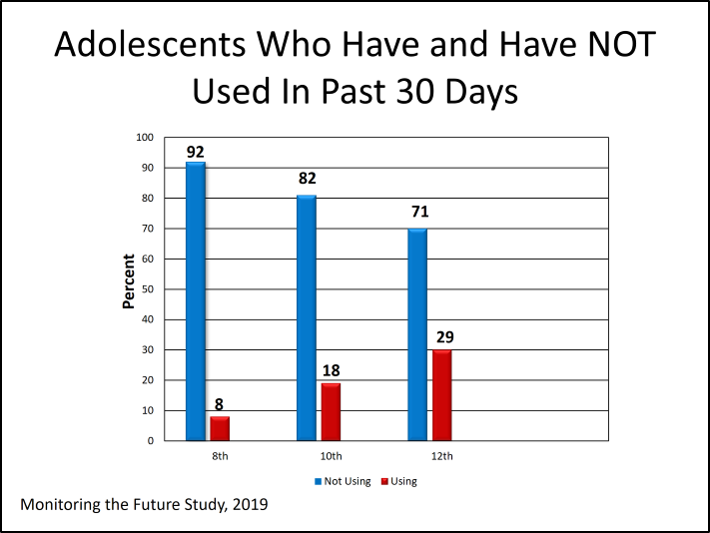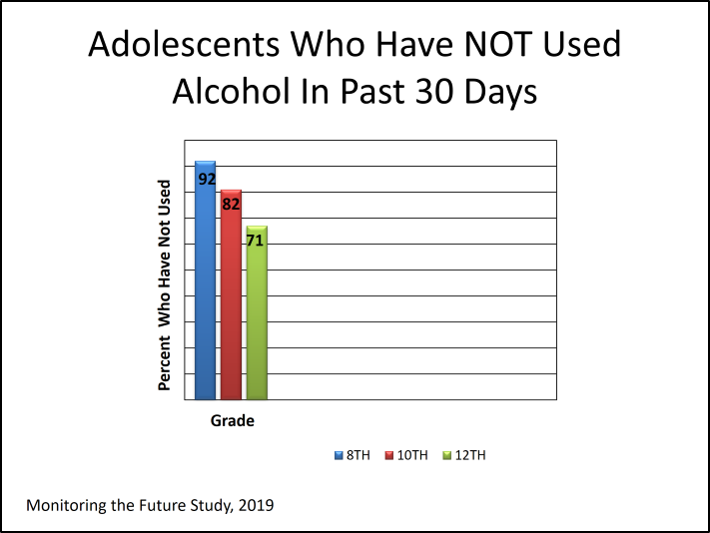Blog
What Is Everyone Really Doing
Author: Kathleen Nelson-Simley
Posted: Thursday - February 27, 2020
“Everybody’s doing it. I’m the only one who isn’t!” I’m sure you have heard your students or maybe your own kids say this to you more than once. They think they are the only one who isn’t wearing the latest fashions, staying out late, having a cell phone, accessing social media or going to a party.
The question is, “Are your kids right? Is everyone their age really doing these things?”
It is somewhat true.
When it comes to drinking, smoking and other risky behaviors there are more kids who begin to experiment with alcohol, tobacco and other risky behaviors in the middle and high school years. If we look for kids who are participating in these behaviors we will always find them. So will your students.
For example, what would catch your students’ attention most – four kids their age vaping or thirty kids who aren’t? What would grab your attention – those who are or those who aren’t?
Your students will very likely pay more attention to the kids who are vaping than those who aren’t and will generalize, from just a few, that lots of kids their age vape. Perhaps you would do the same.
Research has shown that our perceptions drive our behaviors. What we perceive as being normal or common behavior influences what we do. When you couple this along with your students’ increasing need to fit in and be accepted by their peers, the pressure to do what they think everyone else is doing also increases. So, if your students perceive “everyone” or a lot of kids their age are vaping, smoking, drinking or doing other risky things the more likely they will do the same.
One of the most effective research strategies you can use with middle and high school students to influence their attitudes and behaviors is called, “normative beliefs.” Normative beliefs is about two perceptions your students have: 1) The perception of prevalence or how many peers their age they think engage in risky behaviors and 2) The perception of acceptability or how acceptable it is by their peers to engage in risky behaviors.
Let’s focus on the first perception – their perception of prevalence.
The blue line on the graph below shows alcohol usage rates nationally among students in grades 6-12. As you can see, usage does increase over the years. More and more kids are using alcohol.
 |
The red line in the graph shows what students’ perceptions are of alcohol use. As you can see, as kids grow older and move through middle school and into high school they begin to perceive more kids their age are drinking alcohol than what really are.
Why is this a problem?
Remember, perceptions drive behaviors. So, the sooner your students perceive more of their peers are drinking alcohol than what really are the sooner they are likely going to drink alcohol, too.
The research challenges you to correct your students’ “normative beliefs” if you want to prevent them from using. You need your students to see and perceive that a majority of kids their age DO NOT drink alcohol, vape, smoke or use other drugs.
Here’s one way you could begin correcting your students’ normative beliefs…
The 2019 Monitoring the Future national survey asked 8th,10th and 12th graders if they consumed alcohol in the last 30 days. This chart shows the percentage of students who said, “yes”, to the question or who reported using alcohol in the last 30 days.
 |
But, here are the results from the same survey question asked, but instead looking at the percentage of students who said, “no”, to the question. Or, in other words, DID NOT use alcohol in the last 30 days.
What would it look like if we compared the percentage of students who said, “yes”, to the question of drinking alcohol in the last 30 days to those who said, “no”, as I do below? When you look at it this way, what are a majority of middle and high school students doing when it comes to drinking alcohol regularly?
 |
Is “everyone” drinking alcohol or not drinking alcohol?
You are right. Through middle and high school a majority or almost “everybody” is NOT drinking alcohol. This is the perception we need your students to have because it is the reality and the truth.
Kids who perceive a majority of their peers DO NOT engage in risky behaviors are more likely NOT to engage in the behaviors themselves.
Remember, our perceptions drive our behaviors.
Take a look at the results of any survey done locally or in your state of adolescent use of substances. Don’t look at just the statistic of those who reported using. Look also at the statistic that lies within the same survey of those who reported not using. For every number of students reporting they used there is another number of students who reported not using.
The good news is that the number of those who are NOT will almost always be greater than those who are! Your job is to help your students see, believe and perceive this!
So, I have to ask…Is this what you would perceive or believe about kids in your community? Do you believe most of your students are or aren’t engaging in risky behaviors? If your perception is that most are or will, then maybe your perception needs to be corrected, along with your students.
YOU need to believe that a majority of your students are NOT drinking, smoking, vaping and doing other risky things or will in their future if you are going to be effective at helping your students believe it, too.
So, the next time a student says, “Everyone else is!”, don’t believe or agree with them so quickly. Look around. Ask questions. Talk to other students. Chances are the student is already doing what "everyone" else is doing – the right thing. Don’t expect anything different or less.
P.S. A prevention approach using the "normative beliefs" strategy has proven to not only be effective with middle and high school students, but even more effective with college-aged students. Many studies have shown that changing college students' perceptions of drinking norms can lower the proportion of students who engage in binge drinking.






